High-rise multi-family apartments to pioneer first-ever geothermal/wastewater heat recovery system

Egg Geo and SHARC Energy partner to help advance climate-friendly buildings as part of the New York State Energy Research and Development Authority’s (NYSERDA) Empire Building Challenge.
By Nicole Krawcke
The first proposed combined wastewater energy transfer (WET) and geothermal system in the world, the renewable energy system will utilize thermal energy transfer from geothermal energy and energy captured through wastewater flowing through pipes to provide 100% of the heating, hot water and cooling load for Amalgamated Housing Cooperative’s 316 affordable housing units in two 20-story multi-family towers.
Lynn Mueller
Jay Egg
Kristy Egg
Two apartment buildings in the Bronx will soon get their heating, cooling and hot water from wastewater and geothermal energy. No more money down the drain, literally!
The first proposed combined wastewater energy transfer (WET) and geothermal system in the world, the renewable energy system will utilize thermal energy transfer from geothermal energy and energy captured through wastewater flowing through pipes to provide 100% of the heating, hot water and cooling load for Amalgamated Housing Cooperative’s 316 affordable housing units in two 20-story multi-family towers. The project’s goal is to reduce Tower I and Tower II’s energy usage from a site energy use index (EUI) of 111.5 to 40, representing a decrease of 2,741 carbon tons to zero. Currently, the housing cooperative towers use steam heat that runs on fossil fuels.
“Everybody in New York showers, does their laundry and dishes, and that’s just thrown away,” says Lynn Mueller, CEO of Vancouver-based SHARC Energy Systems, the company that makes the WET system that will be used in the project. “It always seemed to me just an enormous waste. That’s why I started SHARC. Why can’t we just get that energy back? The whole premise for SHARC is that we recycle the energy that's going down the drain in the form of hot water. Ab out a third of the energy in the building is required now just for the use of hot water. Every day, people get up and shower, do the laundry, wash dishes and more, and all of that hot water was just thrown away in the past. It would go down the drain, then through the system and out into the rivers and oceans of the world — just gone forever. What we’ve developed and patented is a method to recover that energy to be reused in the building continually. It’s really just the same energy recycled everyday. It’s the ultimate three ‘Rs’ — recycle, reuse and reduce.”
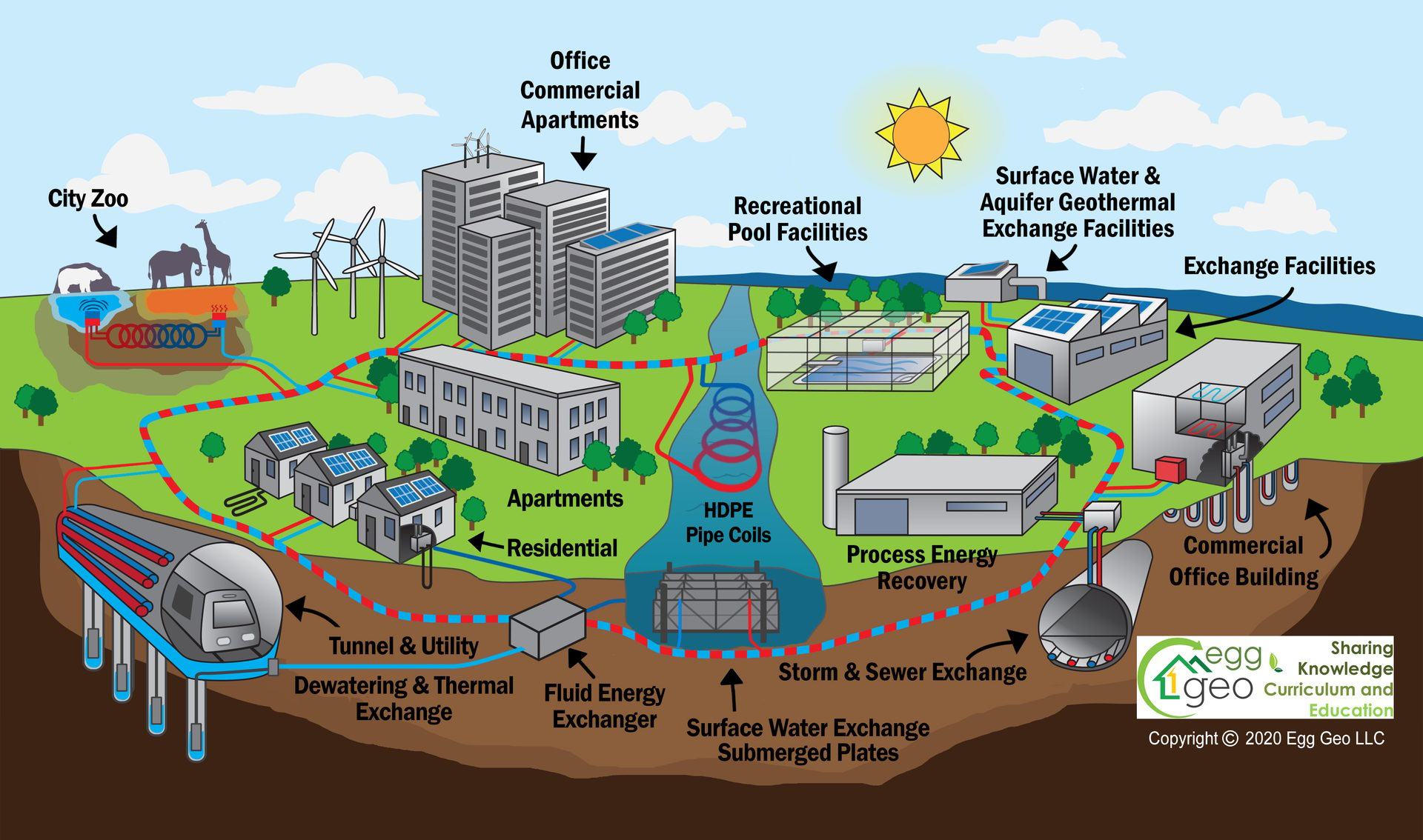
An example of a district energy network with geothermal technology.
What’s neat about the technology is a third of the building energy is just continually reused, Mueller notes. “It never leaves the building, and only costs 25 cents on the dollar to recover it instead of having to remake it every day with a boiler. It's totally green because you're recycling it with an electric heat pump. You don't have to burn any fossil fuels at all to make your hot water.”
Essentially, SHARC will install a large tank in the building’s basement — the size of the tank is calculated based on the needs of the building. The tank will collect the building’s wastewater where it is cleaned and then pumped through heat exchangers in the SHARC system, which extracts the energy needed for the building’s domestic hot water loads, with any leftover energy being used for hydronic heating or cooling. After the heat is captured, the wastewater keeps flowing into the sewer.
Large, multi-family buildings, such as the Amalgamated Housing Cooperative two towers, are ideal for this sort of application, notes Jay Egg, president of Egg Geo.
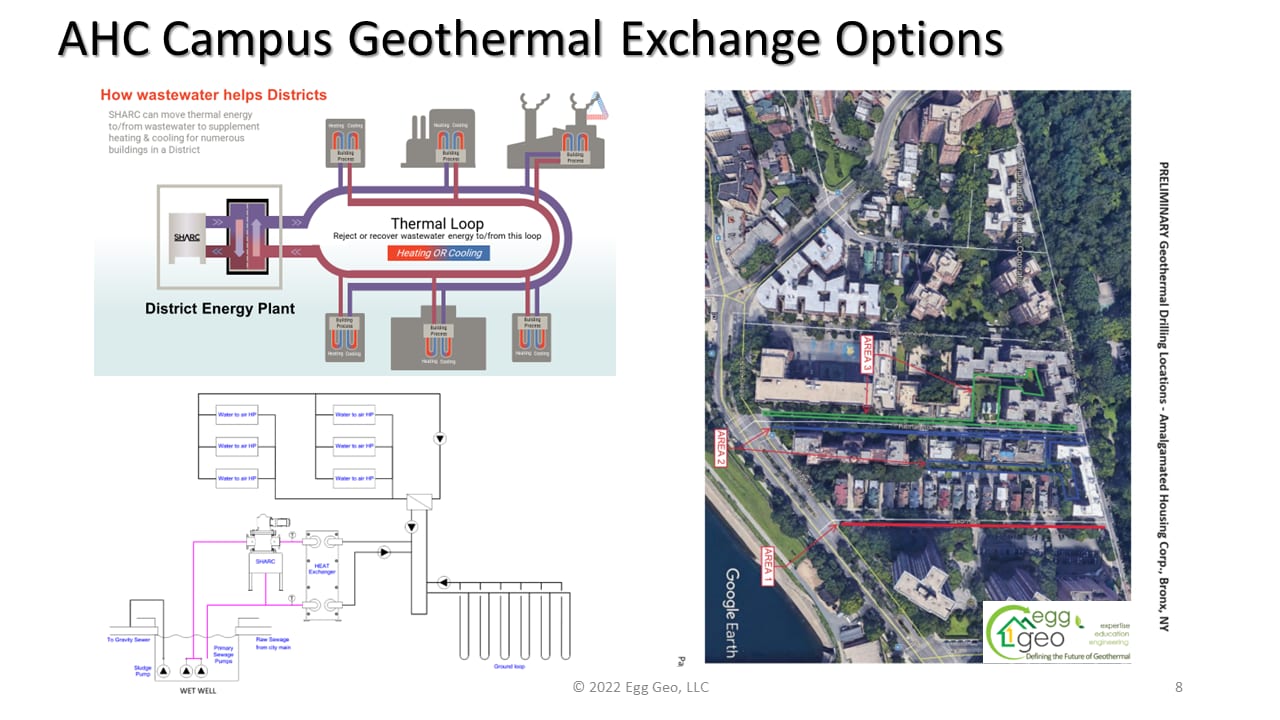
The project’s goal is to reduce Tower I and Tower II’s energy usage from a site energy use index (EUI) of 111.5 to 40, representing a decrease of 2,741 carbon tons to zero. Currently, the housing cooperative towers use steam heat that runs on fossil fuels.
“The more people that live together in a high-rise apartment or an apartment complex are ideal because they have higher than average hot water usage, a common sewer line and a place in the parking garage down below to put the holding tank to hold that energy for use when they need the domestic hot water,” he says.
This first-ever hybrid system also includes a host of benefits which would not be found in choosing alternative renewable energy technologies for the building mechanical systems. Not only is the upfront capital cost significantly reduced because the combined WET/geothermal technology will not require as large of a borefield to meet energy needs, but the smaller borefiled allows for geothermal projects to become more viable in densely populated urban locations, which have limited space. The WET technology allows for reduction in the number of boreholes needed for the geothermal system by 40% or more, Jay Egg estimates. The system can also provide uninterrupted heating, cooling and hot water in extreme weather conditions, and there is an added benefit of the installation being weather resistant as all equipment is installed either indoors or below ground.
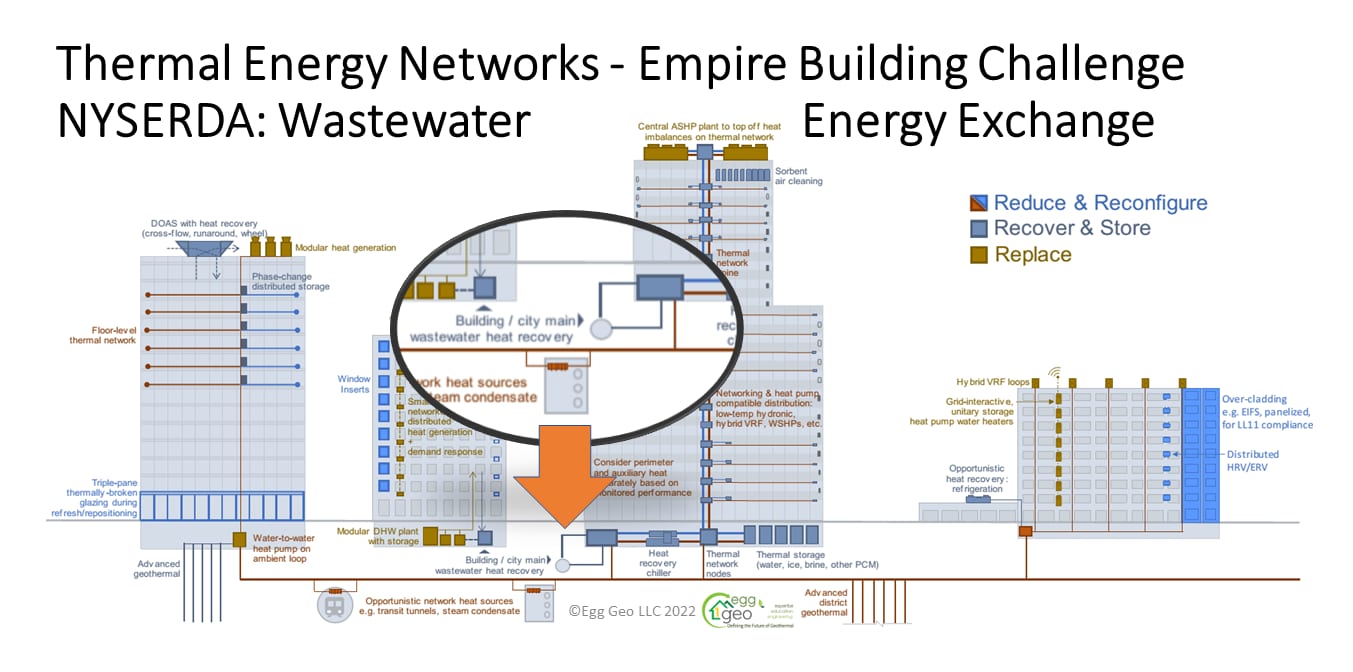
An example of a thermal energy network using wastewater heat recovery.
“If you start at the beginning and consider using air-source heat pumps, well, that’s great until you really need domestic hot water and heating in the middle of winter,” Jay Egg explains. “It gets down to well below freezing in New York. As most people know, the air-source heat pumps will struggle to keep up, and they'll actually spike in electrical consumption. So that makes an air-source solution become a little bit of a problem because they draw so much energy when you need heating the most. New York state sees this as a solution to manage electrical demand on the grid, especially in the middle of winter. There is plenty of scientific proof and actual case studies showing geothermal buildings will use less electricity in the winter than it even does in the summer for cooling. They recognize this as a solution to electrify and decarbonize buildings.”
New York also recognizes its dense population does not offer a lot of land to drill in, Jay Egg notes. “A good high-profile example of a geothermal system that was installed in 2016 or 2017 in New York City is St. Patrick's Cathedral. In order to install that system, they had to close the sidewalks all around the cathedral and drill 10 – 2,200 foot wells to provide heating and cooling. Talk about disruptive, and it costs millions of dollars. With this project, without drilling a single hole, they can at least start by providing all the domestic hot water. And it is considered geothermal exchange by stripping the heat out of the wastewater as it comes out of the building. It's a non-disruptive geothermal technology that will not cause the electric grid to spike in the winter time. That is the real bottom line here. They're trying to find ways to put in geothermal without drilling boreholes because it's so expensive to do in metropolitan areas.”
Jay Egg could only think of one potential downside to the hybrid system, and that is public perception.
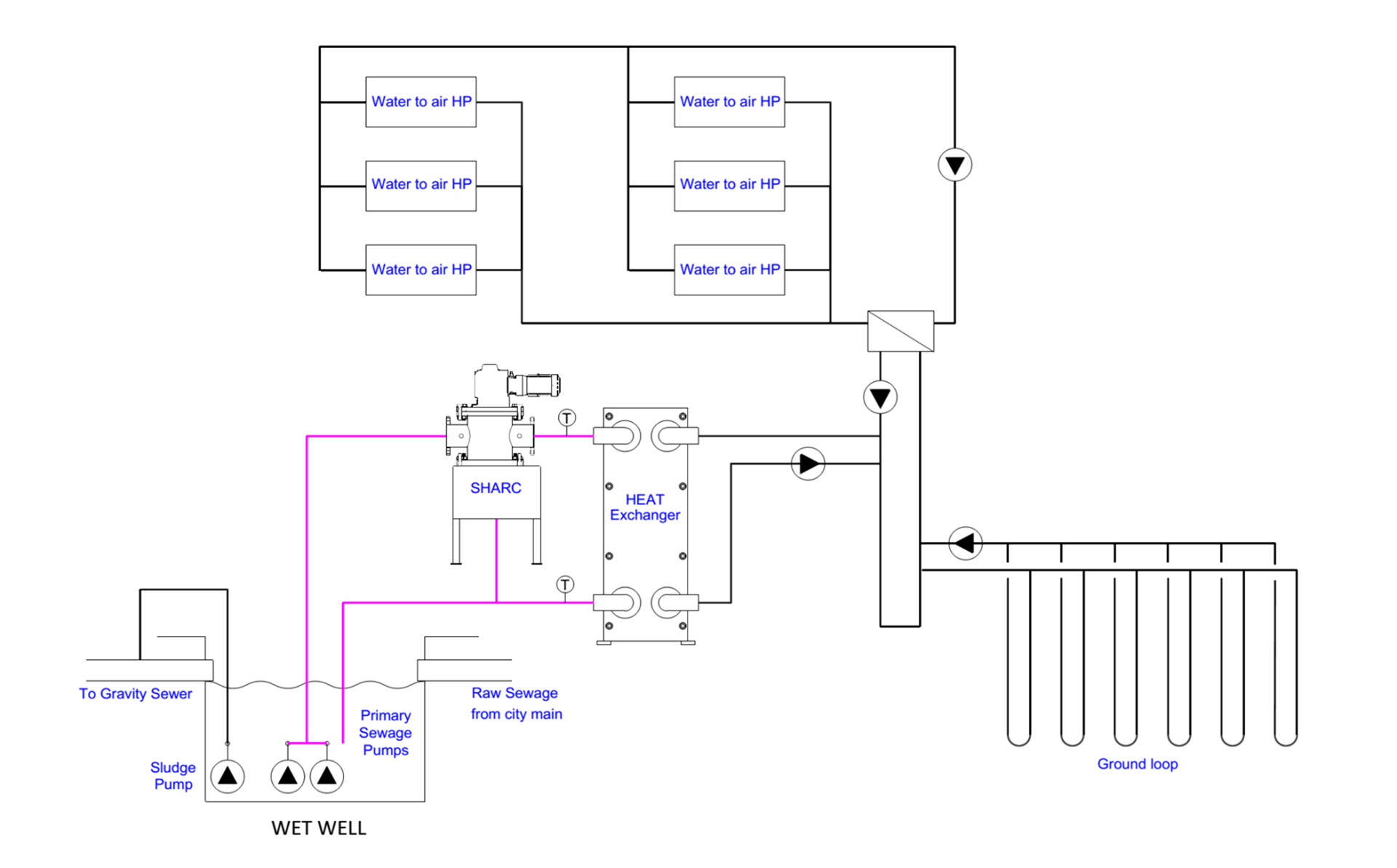
The schematic above shows the wastewater energy transfer (WET) and geothermal system for Amalgamated Housing Cooperative in The Bronx, New York.
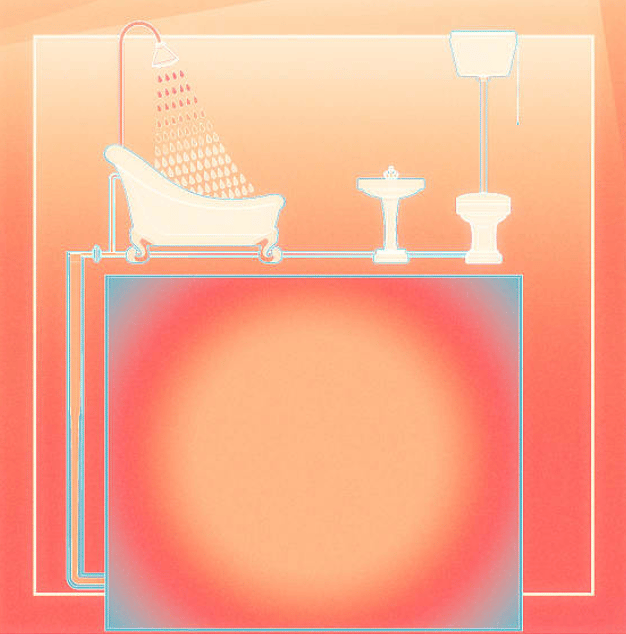
Essentially, SHARC will install a large tank in the building’s basement — the size of the tank is calculated based on the needs of the building. The tank will collect the building’s wastewater where it is cleaned and then pumped through heat exchangers in the SHARC system, which extracts the energy needed for the building’s domestic hot water loads, with any leftover energy being used for hydronic heating or cooling. After the heat is captured, the wastewater keeps flowing into the sewer.
“The No. 1 downside is public perception of wastewater exchange as being something unsanitary for providing domestic hot water,” he says. “It's a little bit hard to get your head around that. Most people just think, ‘Wow, that's gross. You really want to extract heat out of my wastewater. Why don't we just let it go?’ But when you realize that 350 billion kWh a year — enough to basically handle our heating needs for the country — go down the drain, it becomes a real solution. The only downside is getting the word out and educating the public that this is a real technology that is very much low hanging fruit and very low cost as far as a real solution to providing domestic hot water.”
A match made in heaven
Egg Geo has been working in New York as a consultant of sorts for the New York City Council to help explain how to do geothermal in New York City and beyond. Because of their work with the city council, the company was becoming a recognized name in the circles of the big cooperatives in New York City, which led to the partnership with Amalgamated Housing Cooperative in 2019. After conducting feasibility studies, Egg Geo submitted a grant application for the Community Heat Pumps program through NYSERDA on behalf of Amalgamated.
“Right on the heels of that, EnPower, a New York City-based engineer who has been the firm for Amalgamated for a long time, convinced Egg Geo to partner and try winning winning a grant for the Empire Building Challenge, an initiative in which NYSERDA is investing $50 million to demonstrate the technical and economic feasibility of retrofitting tall buildings to low carbon standards, and generating blueprints so building owners can replicate the solutions across their portfolio of buildings.
“We had never considered it before because it’s very high profile,” Jay Egg says. “But when EnPower asked us to go in on it with them as a 50/50 partner, we said sure. And I couldn’t have been more surprised to have won that for anything — I can’t even think of an analogy. We were just really dumbfounded we won. I think the WET and geothermal combined system was the novelty that made it something NYSERDA believed could be duplicated throughout apartments and high-rises throughout New York City.”
Which is when Kristy Egg, research and editorial assistant for Egg Geo, and Jay Egg’s wife, decided to reel in SHARC Energy to the project.
“We’ve known Lynn for years — I’m from Martha’s Vineyard where they filmed ‘Jaws,’ and a lot of my family were in the first two movies,” she explains. “I started joking around with Lynn that it seemed funny that he would do a lot of advertising or bigger shows that happened to coincide when the media frenzy would start for Shark Week. I would send pictures of ‘Jaws’ or something to him, and he would respond, ‘Didn’t mean to, but hey, if there’s blood in the water!’ Then I showed up to his booth one day, and he had a shirt made specifically for me and a bottle opener in the shape of a shark. He said, ‘You don’t even work for me, but I swear you do more social media for us.’ We just hit it off personally. We kept threatening to work together on projects, but it was always hit or miss. So when we had an opportunity to include wastewater energy into our thermal energy network, it was just a symphony. And so here we are with a project taking advantage of his brilliance and Jay’s brilliance, and I’m just very happy.”
“It’s a match made in heaven,” Mueller adds. “We’re thrilled to work with Jay and Kristy because they’ve been such proponents of geothermal. It was maybe eight or nine years ago when we started to talk about the combination of geothermal and the SHARC equipment. I’ve always thought it just made a great deal of sense to use every bit of energy so you can reduce the total need.”
Mueller notes that NYSERDA has been very interested in SHARC technology.
“There are 1.4 billion gallons of sewage a day in New York City, and it’s all been heated an average of about 25° F from hot water being thrown away in buildings. You can image the amount of energy just going down the drain. If you took just one degree back from that flow, you can recover about $3 million with of energy an hour.”
Paving the road to decarbonization
Both Jay Egg and Mueller believe that the WET/geothermal system could offer a solution to how the country meets its decarbonization goals moving forward.
“I do believe that in every single large building — commercial or large apartment building —wastewater energy transfer is the very first thing anybody should consider because it's got the lowest cost and the highest return on investment because of the fact you don't have to drill. Then, when you add the drilling into it and do the rest of the heating and cooling for the building, that cost is greatly reduced. For example, in a building like these two towers here, the cooling load is about 800 tons capacity. And we will be able to save, if you consider all the boreholes that would need to go in for that, they'll probably save $2 to $3 million in drilling costs to do the rest of the geothermal system doing this combined system.”
Jay Egg says he expects to see more of these hybrid systems down the road. “New York is a great leader in technologies. The state alone has presently invested more in decarbonization of building heating and cooling systems than even the federal government. They really are the leader in doing this. What we see happening in New York right now, by 2030, I think this will be so standardized in building construction, it may be kind of like ERVs are required. Think about exhaust recovery ventilators in large buildings. ERVs are required in order to meet the energy goals of buildings. This is essentially an ERV for wastewater. It's an energy recovery vehicle. So I think that what we're going to end up seeing is this become standardized in the energy code as a primary technology. That's truly what I think we'll see by 2030, if not before.”
Mueller adds that in addition to reducing emissions, the system also provides energy security because all the energy is located on-site.
“You don’t have to worry about Putin’s war in Ukraine affecting your price of energy because you've got an indigenous energy supply right on your own land,” he explains. “You never have to pay for energy again. You just pay the 20% it costs to move it. And believe it or not, we've done a number of social housing projects and market housing projects, and people now are demanding a higher level of accountability for the environment from the people that are providing these places. So energy security, everybody in the building will know about it and it's a good feeling to know you're not part of the problem, and you're part of the solution — that’s what will drive this technology forward.
“You won’t be able to do it everywhere, because there just isn’t physically enough room,” Mueller adds. “But most parts of the country are now seeing their air conditioning loads increase way faster than their heating loads. So heating loads are decreasing, air conditioning loads are increasing. Part of what the SHARC does in the summer is uses the air conditioning load for some moist heat, too. It actually lowers the amount of heat you have to put in the loop in the summer. The SHARC system just balances that geothermal system perfectly. I think you'll see SHARCs on almost every geothermal job now, as pressure to decarbonize increases, because it just makes the payback so much faster.”
Photos courtesy of SHARC Energy and Egg Geo.
Nicole Krawcke, is chief editor of PM Engineer.

